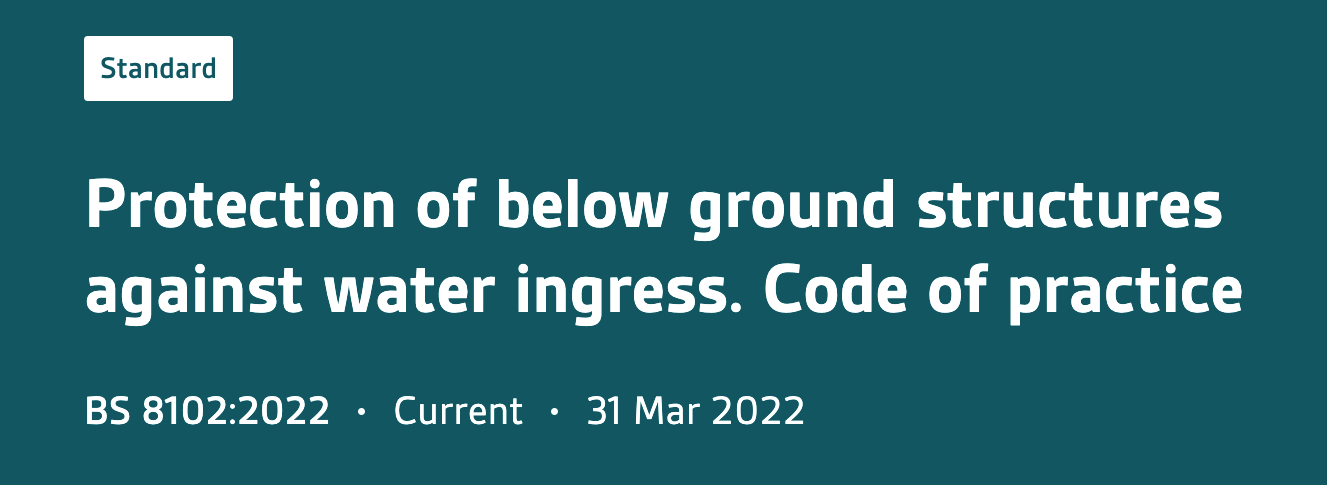01732 360 095
Summary
The British Standard 8102:2022 is the ‘Code of Practice for Protection of Below Ground Structures Against Water Ingress’
What is the British Standard 8102:2022?
The BS 8102:2022 ‘Protection of Below Ground Structures Against Water Ingress’ is a code of practice which takes the form of recommendations and guidance. It is assumed in its preparation that the execution of its provisions will be entrusted to appropriately qualified and experienced people.
BS 8102:2022 recognises that it is essential for the success of any project involving below ground structures that strategies for dealing with all external sources of groundwater, surface/flood water, soil gases and contaminants are considered from the very earliest stages of the planning and design processes.
For new structures, it is recommended that the structural design, overall weatherproofing design and construction processes are considered together, as they generally interact. In addition, it is recommended that during the design process and at all stages of the construction process, the designer’s specialist manufacturers, suppliers and installing contractors establish and maintain effective channels of communication. Regular and clear communication coupled with good site supervision allows variations and amendments to the design to be planned and executed without compromising the performance of the waterproofed structure.

In our experience, this “team approach”, starting from design stage, allows for successful and cost effective waterproofing and, as part of the British Standard rewrite committee, we were very keen for this strategy to be emphasised. A welcome inclusion to the standard now therefore asks for a waterproofing specialist to be included as an integral part of the design team to ensure that an integrated waterproofing solution is realised.
Criteria outlined in the standard are that the individual be:
- suitably qualified and experienced commensurate with the type and size of the proposed project;
- capable of devising solutions that accommodate the various project constraints and needs with an understanding of construction forms and sequencing; and
- provide the design team with information and guidance that assists with and influences the design, installation and future maintenance of the waterproofed structure.
If the RIBA stages are used, a waterproofing specialist should be appointed before the technical design stage at the latest, but we would recommend stage 2 is a suitable time to utilise the Newton Design Service.
Newton Specialist Basement Contractors
Successful waterproofing has always been a specialist area of expertise. The key causes of failure in our experience are poor workmanship, poor product choice for the level of waterproofing required, cheap and inappropriate products substituted for those specified to get inside an unrealistic budget, and products shoehorned into the specification because they hold a sought-after third-party accreditation, but are not the best product for the waterproofing requirement.
The inclusion of a waterproofing specialist in the early stages of the waterproofing discussions will ideally design out the above key causes of failure and provide robust and successful waterproofing projects. For this reason, we partner with an elite group of fully trained waterproofing contractors, Newton Specialist Basement Contractors (NSBC) who can fulfil the role of ‘Waterproofing Specialist’. All our registered contractors offer insured guarantees for the installation and the vast majority of NSBCs hold Professional Indemnity for waterproofing design and installation, giving full protection to all parties concerned.
As members of the committee on the rewrite of BS 8102:2022 we were very keen to promote the inclusion of specialist waterproofing contractors within the project design team, which in our experience results in more robust and successful waterproofing design and installation.
Designing out the potential for defects
The ideal waterproofing solution would be defect-free. However, it should be noted that product or workmanship defects may occur, resulting in the required internal environment not being achieved. The most common defects that we find are:
- defects owing to design;
- defects owing to poor workmanship;
- inappropriate use of the materials being used and defects owing to the specific properties of the materials being used; and
- defects caused by follow-on trades and site operations.
The construction methods, installation personnel, materials and protection thereof used to realise the design should be such that the defects in all of the above are avoided. Contingency planning for dealing with any localised defects or system failures that arise should be included as part of the overall water resisting design of the structure. In either case it is vitally important to take into account the ability to repair the waterproofing system and the feasibility of remedial measures.
The ability to repair external systems has changed the way professional waterproofing contractors can guarantee external waterproofing projects and highlights the practical nature of self-healing ‘Type A’ products such as HydroBond 403 Plus, and the maintainability of Type C drained protection systems such as the Newton CDM System.
Risk Assessment
BS 8102:2022 advises that a risk assessment is carried out to determine the external environmental conditions. As a part of the risk assessment it is also suggested to perform a Desk Study in accordance with BS 5930 and BS EN 1997:
- to assess the geology and hydrogeology, including soil permeability, flood risk, radon, methane and other ground gases and contaminants. (e.g. chlorides and acids)
- to assess the topography of the surrounding ground in relation to the below ground structure
- to establish the likely highest level of the water table and the potential for the occurrence of a perched water table and the impact of flooding; and
- to identify any missing ground and ground water information which should then be obtained by undertaking a site investigation in accordance with BS 5930 and BS EN 1997
The drainage characteristics for analysis of the soil should be determined in accordance with BS 5930.
Taking all the information above on board allows the design team to prepare the most robust waterproofing details to provide the environmental grade that they are seeking to achieve. However, even with all this information, it is a brave individual who seeks not to protect the structure by believing that water will not come to bear against it. Periods of prolonged and heavy rainfall are becoming more prevalent and the design must be able to deal with all eventualities, including burst water mains. It is prudent therefore, that designers deal with the potential for full height of ground water to be bearing against the structure, to ensure that their designs are robust enough to deal with all possibilities.
It is also worth noting that the standard states that: “Even when the site investigation indicates dry conditions, the risk of some waterlogging in the future should be assumed’. Furthermore: “Even in a permeable subsoil, groundwater requires time to drain away and this can result in limited pressure periodically coming to bear against the structure”.
In Conclusion
To sum up, the revision of the British Standard in 2022 includes new technologies available to waterproofing designers, and includes the requirement for a waterproofing design involving a qualified design team, and this has addressed the previous issues which resulted in many failures of waterproofing systems, namely poor workmanship and poor choice of materials.
These changes provide manufacturers, specifiers and end clients with peace of mind that the waterproofing can be installed consistently to a high standard so that as the use of basement space becomes more and more popular, the correct combination of materials and planning is available to get it right the first time.
Speak to our friendly, expert team
Our staff are able to provide guidance for projects of all sizes, whether you require some general advice about damp or waterproofing, or support with technical drawings and specifications.













